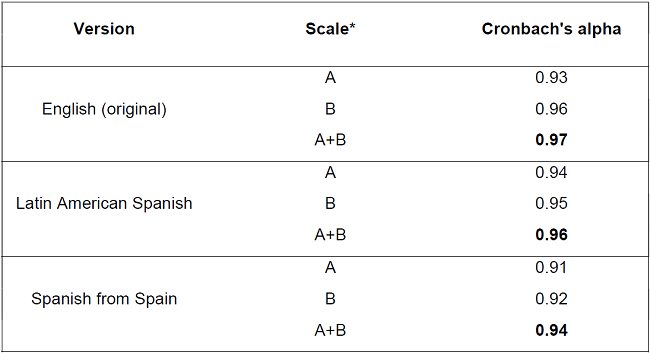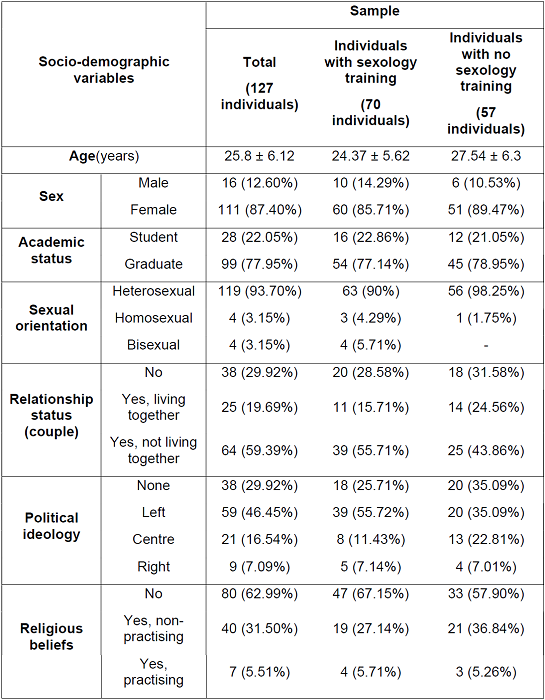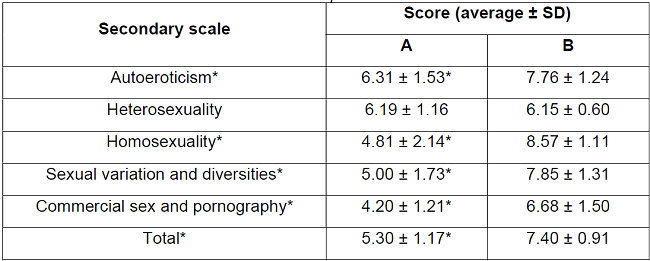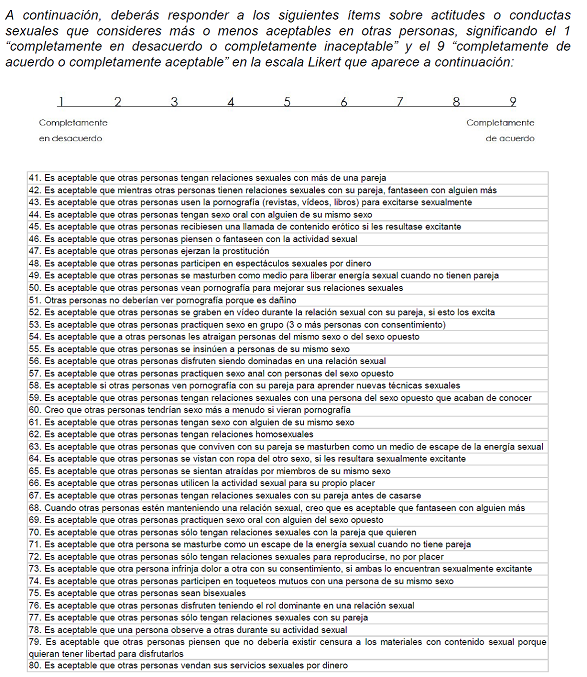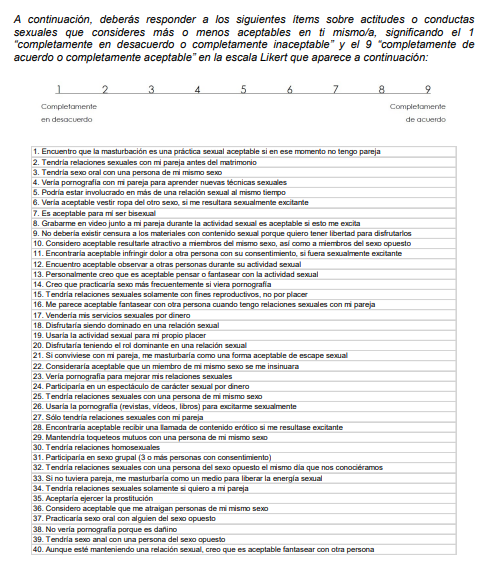My SciELO
Services on Demand
Journal
Article
Indicators
-
 Cited by SciELO
Cited by SciELO -
 Access statistics
Access statistics
Related links
-
 Cited by Google
Cited by Google -
 Similars in
SciELO
Similars in
SciELO -
 Similars in Google
Similars in Google
Share
Enfermería Global
On-line version ISSN 1695-6141
Enferm. glob. vol.23 n.73 Murcia Jan. 2024 Epub Feb 23, 2024
https://dx.doi.org/10.6018/eglobal.568661
Originals
Sexology training and its influence on nurses’ attitudes toward sexuality
1MSc. Nurse specialist in Mental Health, sexologist. Álava Mental Health Network, Basque Country, Spain
2Ph.D. Nurse specialist in family and community nursing, sexologist. Faculty of Nursing of Gijón, Asturias, Spain
3MSc. Graduate in Psychology, sexologist. Camilo José Cela University. Madrid. Spain
4Ph.D. Doctor in Immunology. International University of La Rioja, Logroño, Spain
Background:
Sexology training and a tolerant attitude towards sexuality are key for nurses to be able to approach the topic appropriately at work. Therefore, the main goal of this study is to determine whether sexology training as part of the nursing degree affects students’ attitudes towards sexuality.
Method:
A case-control study was performed on 127 students and postgraduates from Facultad de Enfermería de Gijón, dividing the sample in two groups according to their attendance to specific sexology training. The attitudes were assessed using a translated version of Trueblood Sexual Attitude Questionnaire, and data analysis was performed using SPSS software.
Results:
There are statistically significant differences (p= 0.015) between the mean total score from the group that had received the training (6.53 ± 0.81) and the mean total score from the group that hadn’t (6.13 ± 1.06). Attitudes from members of both groups were more open towards other people’s behaviour (7.53 ± 0.76 versus 7.25 ± 1.06) than towards their own (5.54 ± 1.03 versus 5.00 ± 1.28), respectively.
Conclusions:
It is verified that receiving sexology training correlates with more liberal attitudes towards sexuality. Only 24.8% of nursing faculties in Spain offer specific sexology courses.
Key words: Attitudes; sexuality; nursing; sexology; education
INTRODUCTION
Attitudes can be defined as a set of beliefs, feelings, and tendencies of conduct, which has a mental or cognitive (positive or negative prejudices), emotional or affective (acceptance or rejection reaction) and behavioural (inclination to behave in one way or another) component(1,2).
This analysis of attitudes towards sexuality has been focused along two main lines, that of conservatism-liberalism and erotophobia-erotophilia. The first is the one most frequently used in research on attitudes towards sexuality and focuses on the mental component of attitudes(3).
Less tolerant attitudes, which tend to limit and restrict the expression of sexuality, while accepting and reaffirming traditions, social norms, and socially mainstream views on sexuality, are considered more conservative or traditional. However, more liberal, or progressive attitudes are more tolerant, favouring a free, unrestricted expression of sexuality, as well as individuals' sexual autonomy and freedom(1,3,4).
There are multiple factors that influence the determination or definition of attitudes towards sexuality, among which society or social morality figures as one of the most influential. In addition, gender and sex, family background, sex education or sexology training, religious beliefs, sexual experience, and pornography consumption are also important.
Regarding the research on attitudes towards sexuality, and specifically among university students, it is important to point out that research has been conducted with quite different goals, using a wide variety of measurement instruments(3).
Research on attitudes towards sexuality among nursing students has been almost non-existent until recent years, despite the close relationship between the caregiving role performed in this professional field throughout the life cycle of individuals and the unavoidable presence of sexuality in each of the stages of life(9,10).
In general, research from different countries shows that nursing students tend to have generally liberal or erotophilic attitudes towards sexuality, which tend to become more so as sex education or sexology training is reinforced, and this, as well, supports the approach to sexuality in nurses' professional practice(4,7,11,12.
Nevertheless, the persistence of a certain degree of homophobia or lgtbiphobia among nursing students is reflected, which is related to the association between caregiving and the Christian religion, as well as to the nursing student profile, which traditionally is that of a Caucasian, heterosexual, Christian woman from an upper-middle class social background(11,13,14,15).
It is worth mentioning the research conducted by Rodríguez, Camacho, and Ríos on nursing students at a Colombian university, in which the Trueblood Sexual Attitude Questionnaire was used to measure their attitudes towards sexuality, as a counterpart to this one. Their results, consistent with the above, revealed that students had more liberal attitudes towards behaviours related to heterosexuality, commercial sex and pornography and autoeroticism; and more conservative or erotophobic attitudes towards behaviours related to sexual variations and diversity and homosexuality(4,15).
Regarding sexology training during nursing studies and despite the fact that it is assumed necessary for nursing professionals to integrate human sexuality in their training in order to be able to provide quality care to their patients, who should be understood in a holistic manner, this is very often absent or, on the vast majority of occasions, disguised in order to deal only with genital anatomy, reproduction, pregnancy and childbirth, as well as being approached from a neutral, prohibitive and asexualised perspective(4,16,17,18).
In fact, in a study conducted in 1994, both students and teaching staff at a university nursing school in Alicante considered sexology to be an incredibly important subject in their studies(19). However, the Nursing degree syllabus in most Spanish universities tends to deal with sexology in a transversal manner in several courses and, if it appears as a complete and independent subject, it is usually among the courses known as "electives".
Specifically, in the 2017/2018 academic year, when this research was carried out, out of the 113 Nursing degrees offered in Spain, only 24.8% (28) of them offered an explicit or independent subject on sexology, of which 75% (21) were public institutions and the remaining 25% (7) were private; furthermore, their teaching guides varied considerably.
OBJECTIVES
Main objective
The general objective of this research was to determine whether receiving sexology training during nursing studies has an influence on attitudes towards sexuality among students at the Facultad de Enfermería de Gijón.
Specific objectives
As specific objectives, the following were set out:
- To identify the socio-demographic differences between students who received sexology training and those who did not.
- To learn about the attitudes towards sexuality of the students who participated in the sample.
- To find out whether other variables such as gender, age, relationship status, political ideology, or religious beliefs influence students' attitudes towards sexuality.
MATERIAL AND METHOD
Design, research population and characteristics
A case-control study was conducted at the Facultad de Enfermería de Gijón (Oviedo University, Spain) from September 2017 to June 2018.
The research population comprised 310 individuals. Inclusion criteria included having completed their studies during the 2013/2014 academic year and later or being in their 4th year of the Nursing degree at the time of the research (2017/2018 academic year). University studies prior to the implementation of the Bologna Process (Diploma in Nursing) and having received significant sexology training outside of undergraduate studies were considered as exclusion criteria to avoid possible disaggregation factors when dividing the sample.
Research variables
The variable "attitudes towards sexuality" was considered as a dependent variable in the research.
The variable "sexology training", determined by whether the optional subject "Human Sexuality", offered in the 4th year of the Nursing degree at the Facultad de Enfermería de Gijón, was used as a criterion for the distribution of the sample. Thus, the sample was classified into "case" groups (individuals who had taken the subject Human Sexuality) and "control" groups (individuals who had not taken the subject Human Sexuality).
Other socio-demographic variables analysed were "age", "gender", "sexual orientation", "political ideology", "religious beliefs", "relationship status" and "academic status".
Measuring instruments
An ad-hoc questionnaire was used to measure the independent variables and the Trueblood Sexual Attitude Questionnaire or TSAQ was used for the dependent variable, which was considered the most appropriate given the goal of the research and the research population(3).
The TSAQ was originally drafted in English and designed by Trueblood, Hannon and Hall(20) and later reviewed by Hannon, Hall, Gonzalez, and Cacciapaglia(21). Its purpose is to measure the change in attitude of people who receive sexology or human sexuality training on issues related to sexual behaviour that are commonly covered in such training.
It includes 80 items divided into two scales "attitudes towards own sexual behaviour" (40 items) and "attitudes towards other people's sexual behaviour" (40 items). Each set's items are further subdivided into five secondary scales: "autoeroticism", "heterosexuality", "homosexuality", "sexual variations and diversities" and "commercial sex and pornography".
Each item is scored on a 9-point Likert-type scale, with 1 being "I completely disagree" and 9 being " I completely agree". The scores are evaluated from a conservative-liberal perspective, whereby higher scores in total or in each of the secondary scales indicate a more liberal or tolerant attitude and lower scores indicate a more conservative or intolerant attitude.
The TSAQ questionnaire was translated into Latin American Spanish and validated in Colombia by Rodríguez et al.(15) but it is not adapted to Spanish from Spain. It was therefore decided to carry out a linguistic and cultural adaptation using the Delphi consensus method(22)) contacting a group of 13 experts in different fields (sexology, Hispanic philology, nursing, and psychology) related to the questionnaire's topic, producing a questionnaire adapted to Spanish from Spain (Appendix 1), which was used in this research and subjected to the relevant psychometric tests (Table 1).
Ethical considerations
To contact the students and graduates, a letter was sent to the Dean of the Faculty, requesting access to the information necessary for the research on the fourth-year degree students from the academic year 2013/2014 to 2017/2018. Information (name, surname, and e-mail address) was requested from students enrolled in each complete academic year, and specifically in Human Sexuality during the specified years.
Once the information had been obtained and processed, the questionnaire was sent twice by email to the 310 individuals who made up the research population over a period of one month. The email provided information about the research and the questionnaire to be completed. It was specified that participation was voluntary, that completion of the questionnaire implied consent to participate in the research and that the data obtained was confidential and anonymised. Duplication of results was avoided by a warning in the second send-out so that anyone who had already completed the questionnaire would not do so again. However, a duplicity analysis was performed on the final database and no cases were detected.
The TSAQ questionnaire was generated on the Google Forms platform and a link to access the questionnaire was sent to all members of the research population.
The responses were received anonymously, so it was not necessary to take the precautions required by the Organic Law on the Protection of Personal Data (1999) regarding the storage and processing of personal data, nor the modifications established by the European Data Protection Regulation, in force since 25 May 2018, when compiling the database.
Statistical processing of data
Data analysis and the questionnaire psychometric analysis was conducted using SPSS (Statistical Package for the Social Sciences), version 23.0. A descriptive and inferential (bivariate and multivariate) analysis of the data was performed. Data are expressed as average ± standard deviation (SD). Statistical significance was determined for any p-value < 0.05 and different contrast statistics were used, depending on the characteristics of the data to be analysed.
RESULTS
Sample
Of the total of 310 individuals who comprised the target population, 127 (40.97%) completed the questionnaire and, therefore, made up the study sample.
The sample was analysed according to the variable "sexology training", obtaining a total of 70 individuals who had taken the optional subject "Human Sexuality" (members of the "case" group) and 57 who had not taken it (members of the "control" group).
The remaining characteristics of the sample (total and distributed by groups) are shown in Table 2.
Average total scores
The average scores obtained on the TSAQ showed a statistically significant difference (p=0.015) among the students, where those who received training in sexology obtained higher values (Table 3) and therefore had more liberal or tolerant attitudes towards sexuality.
Group homogeneity análisis
Age was the only socio-demographic variable statistically significant (p=0.003) in the homogeneity analysis, being higher among students who did not take the subject "Human Sexuality" (27.54 ± 6.3 years, compared to 27.54 ± 6.3 years among students who did take the subject).
Relationship with socio-demographic variables
The relationship of the average score obtained in the questionnaire (divided according to scales, secondary scales, and total score) with the different socio-demographic variables of the total sample was analysed, with religious beliefs and political ideology being the only variables in which statistically significant differences were found.
Regarding religious beliefs (Table 4), people who said they had no religious beliefs had significantly more liberal attitudes towards sexuality compared to those who defined themselves as believers and non-religious (p=0.034). Specifically in areas related to homosexuality (p=0.015), sexual diversity (p=0.01) and own sexual behaviour (p=0.005).
Table 4. Average scores for the variable "religious beliefs" in the total sample.
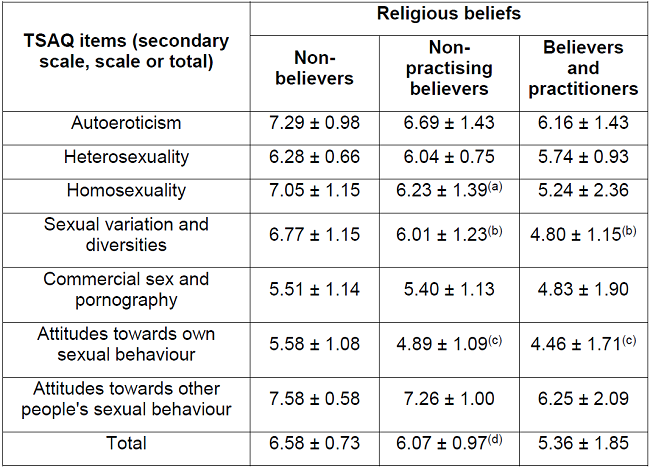
(a)p=0.005 was obtained using the Kruskal-Wallis’s test. Dunn's post hoc test showed differences between "Non-believers" and "Non-practising believers" (p=0.015).
(b)p=0.001 was obtained using the Kruskal-Wallis’s test. Dunn's post hoc test showed differences when comparing the "Non-believers" group with the other groups (p=0.01 in both cases).
(c)p=0.001 was obtained using ANOVA. Tukey's test showed differences between "Non-believers" and "Non-practising believers" (p=0.005) and "Non-believers" and "Believers and practitioners" (p=0.034).
(d)p=0.015 was obtained using the Kruskal-Wallis’s test. Dunn's post hoc test showed differences between "Non-believers" and "Non-practising believers" (p=0.034).
In addition, they also had significantly more liberal attitudes than those who defined themselves as believers and practitioners of a religion, although only about sexual diversity (p=0.01) and one's own sexual behaviour (p=0.034).
Regarding political ideology (Table 5), people who identified as left-wing were found to have significantly more liberal attitudes towards sexuality than those who identified as right-wing (p=0.021). Specifically in areas related to homosexuality (p=0.009), sexual diversity (p=0.017) and own sexual behaviour (p=0.032).
Table 5. Average scores for the variable "political ideology" in the total sample.
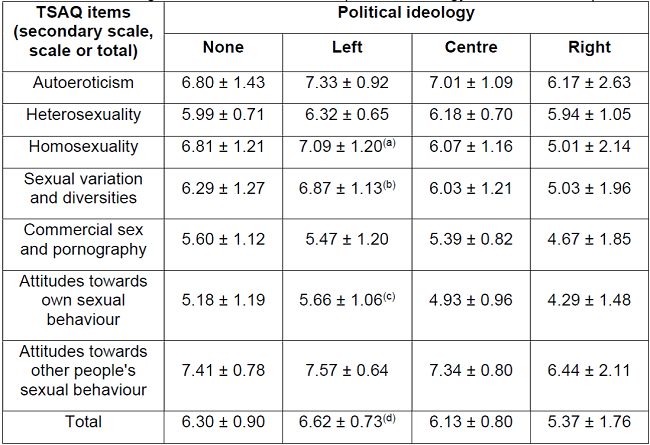
(a)p=0.001 was obtained using the Kruskal-Wallis’s test. Dunn's post hoc test showed differences between "Left" and "Centre" (p=0.011) and "Left" and "Right" (p=0.009).
(b)p=0.002 was obtained using the Kruskal-Wallis’s test. Dunn's post hoc test showed differences between "Left" and "Right" (p=0.017).
(c)p=0.005 was obtained using the Kruskal-Wallis’s test. Dunn's post hoc test showed differences between "Left" and "Centre" (p=0.040) and "Left" and "Right" (p=0.032).
(d)p=0.021 was obtained using the Kruskal-Wallis’s test. Dunn's post hoc test showed differences between "Left" and "Centre" (p=0.034) and "Left" and "Right" (p=0.027).
In addition, they also held significantly more liberal attitudes than those who identified as centrist in their political ideology (p=0.021), specifically about homosexuality (p=0.011) and own sexual behaviour (p=0.040).
Relationship with TSAQ scales
The relationship between the questionnaire average scores items assessing attitudes towards own sexual behaviour (scale and secondary scales) and attitudes towards other people's sexual behaviour (scale and secondary scales) obtained by the total number of participants was analysed.
Overall, participants showed significantly more liberal attitudes regarding other people's sexual behaviour than their own (p<0.001). Specifically, autoeroticism (p<0.001), homosexuality (p<0.001), sexual diversity (p<0.001) and commercial sex and pornography (p<0.001). Table 6 shows the average scores obtained.
Relationship with sexology training
The relationship between the questionnaire scores on the different scales and secondary scales obtained by students who had taken the subject "Human Sexuality" and those who had not was analysed.
Regarding the questionnaire scales, students who received sexology training showed significantly more liberal attitudes towards their own sexual behaviour (p=0.009) than those who did not (Table 7).
Table 7. Average scores according to scales of the TSAQ in relation to sexology training.

*Student T, p<0.05.
Regarding the questionnaire secondary scales, students who received sexology training scored significantly higher (Table 8) on aspects related to heterosexuality (p=0.033) and sexual diversity (p=0.004) than those who did not.
Table 8. Average scores according to TSAQ secondary scales in relation to sexology training.
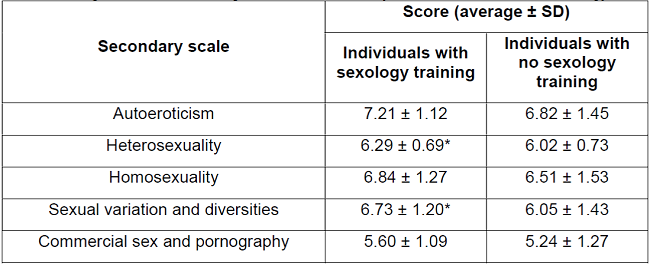
*Student T, p<0.05.
Regarding the analysis of the average scores on the secondary scales within each scale, it appeared that the students who had taken the subject "Human Sexuality" obtained significantly higher scores for autoeroticism (p=0.038), heterosexuality (p=0.019) and sexual diversity (p=0.002) in their own sexual behaviours (Table 9).
Table 9. Average scores on the different secondary scales that make up the scale "Attitudes towards own sexual behaviour" in relation to sexology training.
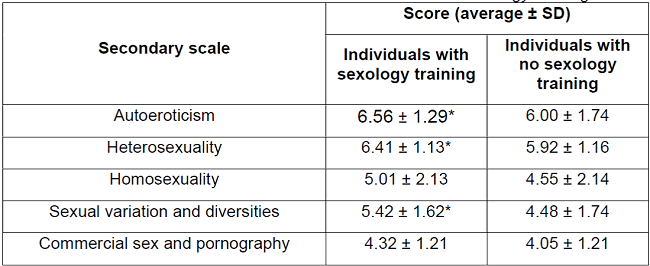
*Student T, p<0.05.
No statistically significant differences were found in students' perceptions of the same valued aspects of other people's sexual behaviour.
Profile of the student taking the subject "Human Sexuality"
A multivariate analysis (ANOVA) was conducted to identify the profile of students who chose to take the optional subject "Human Sexuality", showing that both age (p=0.003) and sexual orientation (p=0.028) significantly conditioned this choice.
It was revealed (binary logistic model, Wald test) that younger age and having a sexual orientation other than heterosexuality (homosexuality, bisexuality) increased the probability of choosing this subject.
Factors influencing the total score obtained
The factors that had the greatest influence on the total score obtained in the TSAQ questionnaire were analysed (multivariate model, step-by-step selection method with p<0.001 and adjusted R2 of 25.27%), obtaining that the fact of receiving training in sexology (p=0.009), being a man (p=0.049), being in a relationship and living together (p<0.001) and having a centrist political ideology (p=0.003, left (p=<0.001) or not having a specific political ideology (p=0.003, left (p=<0.001)), being in a relationship and living together (p<0.001) and having a centrist political ideology (p=0.003), left (p=<0.001) or no specific political ideology (p<0.001) were related to obtaining higher scores on the questionnaire, namely, having more liberal or tolerant attitudes towards sexuality.
DISCUSSION
This research shows that the nursing students in the sample were generally liberal, erotophilic or tolerant in their attitudes towards sexuality.
When analysing and comparing the results obtained in this research with others, it should be noted that there are many factors that can influence them (time or year of completion, culture or country, disparity in the measuring instruments used, differences in sexology training received, etc.). Despite this and pointing to the research carried out by Rodríguez et al.(15), considered as a reference for this one, the results of both studies show that nursing students who receive sexology training have more liberal attitudes towards sexuality than those who do not, being more tolerant towards other people's behaviour than their own.
Regarding other studied variables, it is important to mention the influence of religious beliefs on attitudes towards sexuality. This study found that people are more liberal, erotophilic or tolerant when they do not have religious beliefs, which is consistent with what has been found in other studies(7,11).
However, it should be noted that other research has found that men have more erotophilic attitudes towards sexuality than women(6,8), whereas in this study, although men obtained higher average scores than women (6.61 ± 1.22 vs. 6.30 ± 0.90), the differences were not statistically significant. This can be explained by the unequal distribution of men and women in the sample, as nursing students are mainly female.
Regarding the evaluation instrument of attitudes towards sexuality used in this study, the TSAQ, it is important to highlight that the scores on reliability or internal consistency (Cronbach's Alpha coefficient) of the adaptation carried out on it show, in general, little variability with respect to those obtained in the validation of the original questionnaire(21) and its validated translation into Latin American Spanish(15).
The limitations of the study include the lack of research in the field and in populations with similar characteristics. With regard to the characteristics of the research, it is possible that the fact of choosing to take the optional subject "Human Sexuality" could be a bias if it is assumed that these people have more tolerant or liberal attitudes towards sexuality; also knowing that the training received is specific to the Facultad de Enfermería de Gijón, as the Nursing degree syllabus is not regulated at a national level. Moreover, selecting a large target population in which the vast majority (77.95%) had already completed their undergraduate studies made it impossible to conduct previous and follow-up tests. One possible threat to the external validity of the study is that participants took part intentionally rather than by randomisation.
As future lines of research, we propose to study the relationship between attitudes towards sexuality, sexology training received during Nursing degree studies and its application in daily professional practice when dealing with patients and their sexuality. Also, considering the limitations of this study, to conduct a prospective study with the possibility of conducting a previous test and follow-up test and comparing students from the different faculties where specific sexology training is offered. Furthermore, we consider enriching opening this line of research to the training of other health professionals.
CONCLUSIONS
It is concluded that receiving sexology training is related to having more liberal, erotophilic and tolerant attitudes towards sexuality than not receiving it.
In addition to training, such attitudes may be influenced by religious beliefs (being more liberal, erotophilic or tolerant when not trained) and by political ideology (being more liberal, erotophilic or tolerant when left-wing, as opposed to no political ideology, centre or right-wing).
Sexology training offered during Nursing degree studies in the numerous universities in Spain is scarce, optional, and not very consensual.
REFERENCES
1. Nóvoa Pérez MI, López Castedo A, Sueiro Domínguez E. Cambios en las actitudes sexuales. Estudio preliminar. Actas do X Congreso Internacional Galego-Portuguès de Psicopedagogía. Braga: Universidade do Minho; 2009. [ Links ]
2. López Sánchez F, Fuertes A. Para comprender la sexualidad. 2ª ed. Navarra: Editorial Verbo Divino; 1989. [ Links ]
3. Blanc Molina A, Rojas Tejada AJ. (2017). Instrumentos de medida de actitudes hacia la sexualidad: una revisión bibliográfica sistemática. Revista Iberoamericana de Diagnóstico y Evaluación Psicológica. 2017;1(43):17-32. doi: 10.21865/RIDEP43_17 [ Links ]
4. Guerra VM, Gouveia VV, Sousa DM, Lima TJ, Freires LA. Sexual liberalism-conservatism: the effect of human values, gender, and previous sexual experience. Arch Sex Behav. 2012;41(4):1027-1039. doi: 10.1007/s10508-012-9936-4. [ Links ]
5. Braithwaite SR, Coulson G, Keddington K, Fincham FD. (2015). The influence of pornography on sexual scripts and hooking up among emerging adults in college. Arch Sex Behav. 2015;44(1):111-123. doi: 10.1007/s10508-014-0351-x. [ Links ]
6. Larrañaga E, Yubero S, Yubero M. Influencia del género y del sexo en las actitudes sexuales de estudiantes universitarios españoles. Summa Phicológica UST. 2012;9(2):5-13. doi: 10.18774/summa-vol9.num2-89. [ Links ]
7. Moral de la Rubia J. Religión, significados y actitudes hacia la sexualidad: un enfoque psicosocial. Revista Colombiana de Psicología. 2010;19(1):45-59. [ Links ]
8. Saeteros Hernández RC, Pérez Piñero J, Sanabria Ramos G. Vivencias de la sexualidad en estudiantes universitarios. Revista Cubana de Salud Pública. 2013;39(5):915-928. [ Links ]
9. Guerra Ordoñez JA, Gutiérrez Sánchez G, Ávila Alpírez H, Vázquez Galindo L, García García P, Guerra Rodríguez GM. Actitudes hacia la sexualidad en estudiantes de enfermería. Rev Paraninfo Digital. 2015;22. [ Links ]
10. Benton CP. Sexual health attitudes and beliefs among nursing faculty: A correlational study. Nurse Educ Today. 2021;98:104665. doi: 10.1016/j.nedt.2020.104665. [ Links ]
11. Zambrano Plata GE, Escalante Hernández HE. Grado de homofobia en estudiantes de enfermería de una universidad pública en Colombia. Revista Ciencia y Cuidado. 2013;10(2):115-126. [ Links ]
12. Tugut N, Golbasi Z. Sexuality assessment knowledge, attitude, and skill of nursing students: an experimental study with control group. International Journal of Nursing Knowledge. 2017;28(3):123-130. doi: 10.1111/2047-3095.12127. [ Links ]
13. Lim FA, Hsu R. Nursing students' attitudes toward lesbian, gay, bisexual, and transgender persons: an integrative review. Nursing Education Perspectives. 2016;37(3):144-152. doi: 10.1097/01.NEP.0000000000000004. [ Links ]
14. Güdül Öz H, Balci Yangin H, Ak Sözer G. Attitudes and beliefs of nursing students toward sexual healthcare: A descriptive study. Perspect Psychiatr Care. 2022;58(1):266-272. doi: 10.1111/ppc.12780. [ Links ]
15. Rodríguez Gázquez MA, Camacho Dimaté NJ, Jaramillo Ortiz LC, Ríos Osorio YLA. Actitudes hacia la sexualidad de estudiantes de enfermería menores de 20 años de una universidad colombiana. Avances en Enfermería. 2015;33(1):38-46. doi: 10.15446/av.enferm.v33n1.48189. [ Links ]
16. Sehnem GD, Ressel LB, Frescura Junges C, Machado da Silva F, Nunes Barreto C. A sexualidade na formação acadêmica do enfermeiro. Escola Anna Nery. 2013;17(1):90-96. doi: 10.1590/S1414-81452013000100013 [ Links ]
17. Sung SC, Huang HC, Lin MH. Relationship between the knowledge, attitude, and self-efficacy on sexual health care for nursing students. Journal of Professional Nursing. 2015;31(3):254-261. doi: 10.1016/j.profnurs.2014.11.001 [ Links ]
18. Alonso-Martínez L, Heras-Sevilla D, Charilaou L, Puente-Alcaraz J, Fernández-Hawrylak M. Diferentes actitudes hacia la sexualidad entre estudiantes de Enfermería de primero y cuarto curso. Enferm. glob. 2022;21(65): 473-503. doi: 10.6018/eglobal.474821. [ Links ]
19. Pérez Cañaveras RM, De Juan Herrero J. Importancia de las asignaturas y materias del currículum en la formación de los profesionales de enfermería. Enfermería Científica. 1994;(142-143):69-72. [ Links ]
20. Trueblood K, Hannon R, Hall DS. Development and validation of a measure of sexual attitudes. Presentado en Annual Conference of the Society for the Scientific Study of Sexuality; 1998. Western Region, Honolulu. [ Links ]
21. Hannon R, Hall D, González V, Cacciapaglia H. Revision and reliability of a measure of sexual attitudes. Electronic Journal of Human Sexuality. 1999;2. [ Links ]
22. Varela Ruiz M, Díaz Bravo L, García Durán R. Descripción y usos del método Delphi en investigaciones del área de la salud. Inv Ed Med. 2012;1(2):90-95. [ Links ]
Received: May 03, 2023; Accepted: August 12, 2023











 text in
text in 

